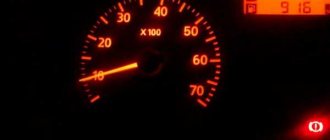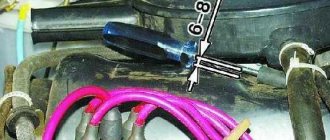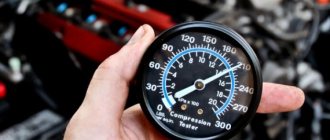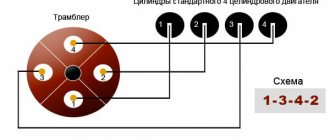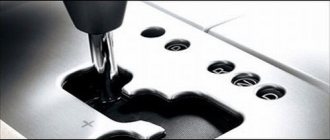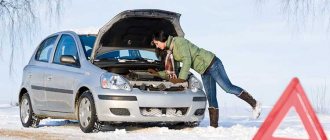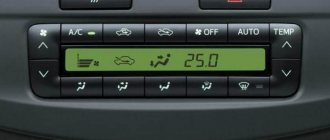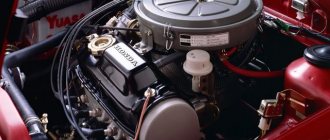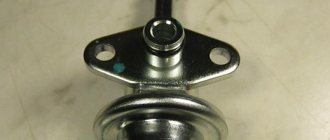The speed drops when you press the brake: possible causes, solutions and recommendations
A car is a multifunctional system, where the coordinated and synchronized operation of all mechanisms and each component separately is important. Various failures and breakdowns of at least one of the parts may lead to violations of the clear algorithm of operation of other systems. You can often encounter a situation where the speed drops when you press the brake. This problem is often addressed to auto mechanics. If during braking the speed suddenly begins to fluctuate, you should not wait until the car stops. Soon after this, the engine will begin to vibrate violently and stall. By the way, the problem is relevant only on gasoline engines.
Other possible causes of brake pedal beating
The cause of pedal beating may be uneven wear not only of discs or drums, but also of pads. During the braking process, the friction composition from which the clamping elements are made heats up to a very high temperature. Despite the fact that asbestos, which is very resistant to strong heat, is used as a reinforcing material, even it is unable to withstand significant temperature effects. When the pad pressure pad thins unevenly, the reverse hydraulic effect described above occurs, which causes the brake pedal to run out.
Vacuum booster
If the engine speed drops when you press the brake, the fault is the vacuum booster or its component parts. Often this problem occurs due to the design features of this mechanism and the principle of its operation. This mechanism is housed in a round closed case. It is located under the hood, not far from the brake pedal. The master cylinder is connected to the housing. The main task of this unit is to reduce the pressure on the pedal when reducing speed. The amplifier is based on a diaphragm.
Principle of operation
The main task of the amplifier is to maintain a vacuum in two communicating chambers at a time when the valve is open and the brake is not pressed. If you press the pedal, the element will close. In this case, a powerful vacuum will arise in the part responsible for the vacuum. To obtain this vacuum, a pipeline leading to the intake manifold of the power unit is connected to the chamber fitting. The mechanism also has a return spring.
Relationship between crankshaft speed and brake booster
As noted above, the vacuum booster is in direct connection with the intake manifold. Therefore, any violation of the manifold seal will negatively affect the quality of the air-fuel mixture that enters the engine cylinders. A mixture of air and fuel, where there is not enough oxygen, will not burn completely. Therefore, the power unit loses power and efficiency.
Vacuum brake booster - how to diagnose a malfunction
Diagnosing a malfunction of the vacuum brake booster is not difficult; it becomes noticeable - when pressed, the brake pedal becomes hard. But an indirect sign of a malfunction can also be a change in idle speed when the pedal is pressed . This is due to a lean fuel mixture caused by “excess” air entering the engine cylinders, which may even stall if the “suction” is too strong.
Most often this is due to damage to the brake booster diaphragm. And it’s not necessarily due to old age - sometimes the sealing rings of the main brake cylinder leak brake fluid, and it gets into the booster housing.
New vacuum brake booster for VAZ 2109
Diagnostic methods
If such problems arise while using the car, you must immediately find out what exactly the fault is. The fact is that the situation when the speed drops when you press the brake is very unpleasant. If at first the speed drops only slightly, then after a while the engine will simply stall when you lightly touch the brake pedal. This can happen at the most inopportune time. Note that even in a fully functional car, the speed drops when you press the brake, but this drop is insignificant. This happens due to the design of the amplifier.
Hose
When the drop in speed is quite significant, then it is necessary to carefully visually inspect the hose connecting the amplifier and the intake manifold on the engine. If there is visible damage on the tube, and this can be various cracks or tears, then the tightness of the collector is broken. What's the result? The process of normal preparation of the fuel mixture changes, which is why the stable operation of the engine is disrupted. That's why when you press the brake pedal, the speed drops and the engine stalls.
The level of hissing when you press the pedal - which is normal and which is not
There is a category of drivers who listen very carefully to every slightest squeak or sound and try to hear signs of a breakdown. A car is a mechanical vehicle that contains a sufficient number of components and mechanisms that can create a small permissible noise level. You shouldn’t listen too much to this and go straight to the service center, where, with a lot of persistence, they will definitely find the problem and offer to fix it. The brake pedal, when pressed, in most cases emits a slight hiss.
Vacuum brake booster for VAZ 2109
It must be said that you need to check the brakes for various noises while the car is running. In this case, windows and doors should be closed, and all devices that can make additional noise should be turned off, if possible. A small noise level in the cabin may occur due to the design of the brake system, which, as a rule, has two vacuum chambers. When you press the brake pedal, different pressures arise in them, which is why a slight hiss occurs. If it is minimal and almost imperceptible, then there will be no problems when braking.
If at idle, when you press the pedal, you hear a loud, choking sound or a strong hiss, and it is pressed tightly, then you need to look for problems. First of all, the vacuum booster is checked. A stiff pedal is not a sign of a breakdown of this part, especially in severe frost, but, coupled with hissing, it indicates the need to check it.
The brake system is constantly used by the driver, so the elements of the system are under load. Whatever driving style the driver preaches, over time it is necessary to check the brakes for serviceability. This will ensure the safety of all road users.
The vacuum amplifier has a diaphragm, which over time, like any rubber material, begins to burst and crack. This does not allow it to fully fulfill its functional purpose - to pump up the necessary pressure. The intake vacuum can also fail, but more often this is the first option.
Vacuum booster diagnostics
So, if you notice a drop in speed when you press the brake, then the first thing you need to do is check the amplifier for serviceability. Of course, you can go to a carburetor specialist. But this is unlikely to solve the problem of falling speeds. If there is depressurization, this will lead to air entering the intake manifold. As a result, the speed drops when you press the brake. The fuel-air mixture becomes sharply lean. There is also another diagnostic method. Press the brake pedal up to six times with the engine off. Then the pedal is fixed in the middle position and the engine is started.
Why does the pedal hit when you press the brake?
The brake system of a car consists of a small number of components. Therefore, you can quickly determine why the car behaves this way. On the other hand, they all influence the behavior of the brake pedal to a certain extent.
Brake discs
The obvious reason is that the brake disc has a broken geometry. Curvature occurs due to a sharp temperature change. When driving in the mountains, the working surface quickly heats up. Deformation occurs due to sudden cooling, caused, for example, by falling into a puddle. To fix the problem, you need to replace or sharpen the set on the axle.
Not always, but vibration can appear after repair work. After grinding in the new parts, the problem will disappear.
Pads
Both the front and rear sets are subject to diagnostics. If the pads are worn beyond the maximum allowable value, the owner should replace them as soon as possible. The kit is installed in pairs, on each side of the axle. This is necessary to evenly distribute loads throughout the braking system.
Brake cylinders
A characteristic symptom of a damaged or deformed cylinder is the presence of traces of DOT 4 fluid on the inside of the wheel, sometimes on the asphalt. If the part is intact, it is necessary to lubricate it, thereby preventing jamming. The danger of fluid leakage is explained by the possibility of completely losing the brakes, which will lead to an accident.
Rear drum
On domestically produced cars, disc brakes with a caliper are often installed at the front. Since the rear axle consists of an axle, the designers decided to install a drum. After removing the protective cover, you need to check the condition of both the drum itself and the pads. If they are severely worn, they need to be completely replaced.
Possible reasons
If the speed drops when you press the brake, it is not recommended to drive such a car until it is repaired - the brakes may break. It is worth checking the vacuum brake booster.
The VUT is connected to the manifold using a vacuum hose. The VUT design includes many elements, but the first thing you need to look at is the membrane. Its damage is the main reason for the drop in speed when you press the brake pedal. If you press it sharply, the faulty membrane will not have time to create resolution, so air from the braking system will penetrate into the fuel.
The VUT hose is checked by eye. You can examine it like this: disconnect the hose, start the engine, and pinch the hole where the hose was with your finger. If the hose has not lost its tightness, the motor will increase speed, and when you remove your finger, it will slow it down again. If during the procedures the motor operates at a steady speed, it means that the hose is leaking.
Sometimes the cause is the fuel filter. This applies to both carburetors and injectors. The filter must be removed and inspected for contamination. It is better to change it immediately if the resource has come to an end. As for cars with injection engines, their fuel filters need to be changed regularly, because it is almost impossible to visually diagnose them.
If the filter on the injector is clogged, the fuel pump will not be able to supply the required amount of gasoline to the engine, causing a loss of traction. If such a situation occurs, cleaning additives cannot be used - they will soften the collected dirt, which will disperse inside the system. Then you won’t be able to do without a comprehensive cleaning.
In cars with installed gas equipment, the engine may stall due to an incorrectly configured gearbox. This usually happens at high speeds when you apply too much pressure to the brakes. The throttle will be closed, and the return air will make the mixture leaner. On vehicles with LPG, the solenoid valve filter may also become clogged, but it is not used on all sets of equipment.
If a car runs on low-quality fuel, its throttle valve may become clogged. This is another probable reason for the drop in speed. Contamination will prevent the valve from working to form a good fuel mixture, so the liquid will turn out to be too concentrated.
Why does the brake pedal hit when braking?
Many motorists on the road are faced with situations when the brake pedal begins to hit their feet during braking. At the same time, this phenomenon is observed not only in old cars, but also in modern ones. Some motorists compare this to the operation of ABS. All this can be complemented by the appearance of vibration in the steering wheel. This can occur due to the presence of various defects, so it is very important to promptly identify the causes.
Every motorist who takes good care of his vehicle tries to pay attention to all the changes in it. Sometimes various sounds or knocks may occur, which are accompanied by vibration. For example, while driving, when you press the brake pedal, it can hit your leg. And such a phenomenon can occur for a variety of reasons.
Crooked discs are the most common cause of brake wobbly. As a rule, this occurs in cars that are operated at a strenuous pace - the driver brakes sharply, starts and turns at high speed. The discs are heating up at this moment, and if the car drives through a puddle, deformation cannot be avoided. The geometry is checked using a dial indicator or in a simpler way. It is necessary to remove the wheel, place the vehicle on a jack, start the power plant and engage first gear. Don't be afraid that the car will move forward. The procedure requires one more person to press the brake pedal slightly. During this time, the owner must keep an eye on the floating caliper and brake rotors. If they begin to twitch with a certain frequency, then the disc is curved. To eliminate the defect, you need to replace the disks. Sometimes they are simply turned on a lathe. However, there are some disadvantages here - not all disks can be used for a long time after such a procedure. There is a possibility that they will soon bend again and a knock will appear when braking.
Corrosion and wear . Sometimes the driver replaces the brake pads with new ones, and then encounters a beating in the brake pedal. This may indicate rust on the brake discs or too much wear and tear. As a rule, this phenomenon occurs over several hundred kilometers; over time, the intensity of the knocking becomes less and less. Old pads wear out along with the disc. In places where they are not adjacent to each other, rust appears. Gradually its thickness increases. New brake pads have a larger working surface. Due to the appearance of a gap, the parts are not completely adjacent to each other. As a result, vibration and vibration may occur during braking. To solve the problem, you can contact a turner. Grooving helps in most cases. If the reason is the presence of corrosion, it can be beaten off with a hammer.
Hub or bearing . A very rare reason - the hub has moved. In this case, you need to diagnose the wheel bearing, as sometimes it plays. If everything is fine with it, you need to replace the hub.
Bottom line . When braking, the pedals begin to knock - this can occur for some reason. It is best to contact specialists and fix the problem in advance.
How to diagnose yourself
You need to diagnose the fuel pump on the injector by checking the pressure in the fuel line. A pressure gauge is used. When checking a carburetor engine, the algorithm of actions is as follows:
- We dismantle the clamps and disconnect the hose for the gasoline outlet from the pump.
- We bleed the pump. Here we use the lever for manual pumping.
- When the pump is working, gasoline will definitely come out of the hole.
- Checking the inlet pressure. Disconnect the suction hose and activate the pump. It is necessary to cover the inlet hole with something. When the pump is running, a vacuum is formed at the inlet. The absence of vacuum will indicate a component failure.
To diagnose the idle speed sensor, you will need a multimeter (to measure DC voltage). First, remove the sensor and check the control circuit. Then we connect one of the voltmeter contacts to the ground of the car, and the second to the block. Each car has different power supply pins, so you should first familiarize yourself with the car’s electrical diagram. Now you need to turn on the ignition and look at the tester readings. Normal voltage is 12 volts. If it is missing, this indicates a break in the control circuit. If the circuit is working properly, you need to examine the sensor itself. Again we take a tester, with which we check the sensor winding.
How to fix the problem
Now let's talk about eliminating the reasons for the drop in speed.
Vacuum booster
The vacuum amplifier cannot be repaired - only completely replaced. Sometimes craftsmen do take on the task of repairing VUT, but this happens rarely, and it is not advisable for every car. Repairing the vacuum booster hose is also difficult - it’s easier to replace it with a new one.
Gasoline pump
You can try to repair the fuel pump. In a mechanical fuel pump, you need to start by replacing the diaphragm and valve; sometimes the pusher along with the spring is changed. If the housing is damaged, the assembly is completely replaced. Also, a complete replacement is needed for in-depth repairs.
In an electric fuel pump, the engine brushes and plastic coupling are replaced. If the anchor fails, it is rewound.
Idle speed sensor
Unfortunately, it is impossible to repair this part, so we replace it with a new one.
HBO blockage
Usually, the solenoid valve filter gets clogged on cars with LPG. It can be cleaned or replaced. Some models have “winter” and “summer” regulators. They should be displayed according to the season.
Throttle valve
If the diagnosis reveals that the valve is clogged, remove the entire throttle assembly and clean it with special sprays for cleaning the carburetor.
In engines with injectors, we clean the injectors. We use cleaning additives. We remove the nozzles and wash them in an ultrasonic bath.
Common reasons why a car stalls when braking
Sometimes it happens that when braking, the car engine stalls - an unpleasant situation, especially in dense traffic on city streets, at intersections. And on a free road, this problem also does not evoke positive emotions.
This malfunction occurs regardless of the modification of the car - with a diesel engine, gasoline engines with carburetor and injection fuel supply systems. But most often cars with carburetors stall when braking, although modern technologies do not guarantee stable engine operation.
Why does the car stall when braking: the main reasons for the engine stopping
Many car enthusiasts, when starting the engine, believe that it works without any problems and immediately gains the necessary characteristics for uninterrupted operation. After a short warm-up, the car starts normally, but when braking, it stalls, most often at the moment when the clutch is depressed.
To understand the situation, just look at the tachometer or listen to the sound of the engine. When you press the clutch, the speed drops abruptly to a minimum level at which the engine stalls. Moreover, such a problem may occur only occasionally, which complicates the identification of the malfunction. The engine may stall when braking without pressing the clutch, or simply when braking the engine.
From this we can conclude that the car stalls in transient modes when the gas pedal is released and the throttle valve closes. At this moment, the idle system begins to work, but this does not mean that it alone is responsible for the problem that has arisen.
If the car stalls while braking, the first thing to check is the condition of the braking system. To do this, you need to pump the pedal five to six times and leave it depressed to the bottom point. This is done with the engine off, after which it starts, and the pedal should rise to its normal functional state, and the brakes should engage normally. If this does not happen, the brake system needs to be diagnosed and repaired.
Experts include the following reasons why the engine stalls when braking:
- breakdown of the brake vacuum booster, its depressurization;
- a burst and depressurized vacuum booster hose;
- in engines with fuel injection, the idle speed sensor may fail;
- failure or problems with adjusting the throttle position sensor or its clogging;
- tank clogging or fuel pump failure.
Breakdown of the vacuum brake booster (VUT)
This unit reduces the force exerted by the driver's foot on the brake pedal. It is located in front of the master cylinder and consists of a vacuum hose and an intake manifold. Its design includes a flexible membrane or VUT diaphragm. With fast and sharp braking, even microscopic depressurization of the vacuum booster leads to problems.
During operation, the membrane periodically moves back and forth. As a result of wear, it stretches in the middle part and cracks, allowing air to pass through. It is no longer able to create a vacuum, and air enters the fuel mixture, disturbing its balance. To identify problems with the diaphragm, you will need to do several simple procedures:
- Turn off the engine.
- Press the brake pedal up to 6 times, “pumping” it, with each new press the pedal stroke should become tighter.
- Keep the pedal pressed and start the car engine.
- If the pedal “falls through” when the engine is running, the brake booster works normally; if the pedal does not respond, this is a sign of a ruptured membrane, and the problem must be solved urgently.
The serviceability of the VUT diaphragm can be checked in another simple way:
- the car starts and runs for several minutes, then the brake pedal is pressed;
- the car engine turns off;
- it is held pressed for at least half a minute;
- the pedal must remain pressed and not try to rise, but if it rises or resists your foot, the vacuum booster of the brake system is faulty.
Possible causes of vibration when braking
So let's go according to the list above:
- If vibrations are felt not only when braking, then the problem is most likely complex and lies in both the brake system and the chassis. Even the wheels of your car may be at fault. How will become clear later.
- If vibrations only appear when braking and you feel kickback in the brake pedal, then the problem is in the brakes themselves and, possibly, in the wheels. The remaining components - suspension and steering - can be excluded from the search.
- Vibrations in the steering wheel when braking most often indicate wear on the steering tips and problems with the brake pads or discs. Vibration is transmitted to the steering wheel from the brakes through loose parts of the steering mechanism. As a rule, if the tips are worn out, vibration and knocking are felt even without pressing the brake pedal - when hitting bumps, potholes, speed bumps, and so on.
- If the car body vibrates when braking, it will be very difficult to diagnose the problem. Such defects indicate not only a faulty brake system, but also serious problems with the suspension.
- If vibrations are more pronounced when braking at high speeds, then the brake pads or discs are most likely to blame. If the defect occurs at a relatively low speed, then there may be defects in the tires, unbalanced wheels, or bent rims.
- If when braking you not only feel vibrations, but also hear a squeaking or metallic grinding sound, the brake pads (or one of the set) are clearly worn out. The pads have simply worn down to a metal base, and when braking, this metal rubs against the metal of the brake disc or hub.
- If there is vibration when braking and the car pulls to one side, this will simplify diagnostics. If you are pulled, for example, to the right when braking, then the brakes on the left side do not work fully. Perhaps the defect should be looked for from this side first.
- Quite often, vibrations during braking appear immediately after repair of this unit. There may be several reasons. First, the brake pads were not installed correctly. Secondly, they have not yet gotten used to the brake discs. Thirdly, new pads are installed without diagnosing and repairing the mating part - the brake discs may have significant wear or irregularities that cause vibration during braking.
- If you recently bought a completely new car, and soon noticed vibration when braking, then the brake pads simply did not get used to it. As a rule, after 200-300 kilometers the defect disappears on its own. When buying a used car, the nature of the problem is most often the opposite. Vibrations appear just after a run of 200-300 kilometers. Most likely, low-quality parts were installed during the pre-sale preparation of the car, or you were sold it with “breathable” brakes.
- If everything was fine before switching to winter or summer tires, then the problem should be found in the wheels. Firstly, you could install other wheels with new tires - bent, burst, and so on. Secondly, you could save on wheel balancing, which can also lead to vibrations during braking. Thirdly, you have not installed new tires, which may have defects - torn cords, hernias, bad tires, and so on.
If all of the above did not help to immediately determine why there is vibration when braking, proceed to direct diagnosis and search for the problem in the garage or in the inspection pit.
